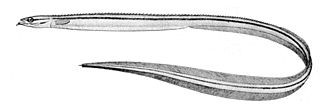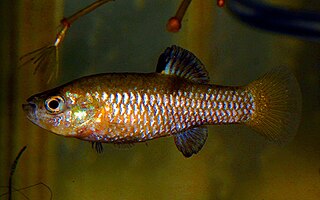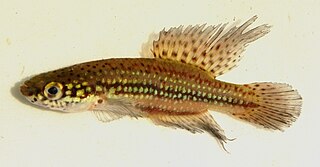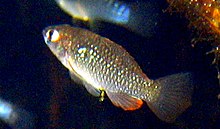
Mackerel is a common name applied to a number of different species of pelagic fish, mostly from the family Scombridae. They are found in both temperate and tropical seas, mostly living along the coast or offshore in the oceanic environment.

Herring are forage fish, mostly belonging to the family Clupeidae.

The Gonostomatidae are a family of mesopelagic marine fish, commonly named bristlemouths, lightfishes, or anglemouths. It is a relatively small family, containing only eight known genera and 32 species. However, bristlemouths make up for their lack of diversity with numbers: Cyclothone, with 13 species, is thought to be the most abundant vertebrate genus in the world, numbering in the hundreds of trillions to quadrillions.

Citharichthys is a genus of flatfish in the large-tooth flounder family, Paralichthyidae. They have both eyes on the left sides of their heads. They are native to the oceans around the Americas, with a single species, C. stampflii off the West African coast. Most are found in relatively shallow depths, but the genus also includes species found in deep water and species that enter fresh water.

The quillfish, Ptilichthys goodei, is a species of perciform fish, the only species in the genus Ptilichthys and family Ptilichthyidae. It is an elongated, eel-like fish that reaches 34 cm in length. It is native to the north Pacific Ocean, from the Bering Sea south to Oregon.

Fundulidae is the family of topminnows and North American killifishes.

The banded lampeye is a species of poeciliid that is native to Africa, ranging from Senegal to Angola. It is mainly found in coastal brackish habitats such as river mouths, lagoons and mangrove swamps. It reaches up to 7 cm (2.8 in) in total length.
The Clear Creek gambusia is a species of fish in the family Poeciliidae endemic to the United States, particularly Menard County, Texas.

The Cuatro Ciénegas killifish is a critically endangered species of fish in the family Cyprinodontidae. It is endemic to Cuatro Ciénegas in Mexico.

The blue lyretail, also known as steel-blue aphyosemion and Gardner's killi. It is a species of killifish from Nigeria and Cameroon.

The rainwater killifish is a small silvery fish with yellow flashes and diamond shaped scales that is widespread from Cape Cod, Massachusetts, through to Tampico, Mexico. It is commonly found in large numbers in fresh to brackish estuarine environments. It feeds on tiny crustaceans, mosquito larvae, small worms, and mollusks. It can reach up to 62 mm.

Heterandria is a genus of livebearing fishes within the family Poeciliidae. Most species occur in Guatemala and its surroundings, particularly Mexico, but the midget livebearer (H. formosa) comes from the southeastern United States.

Fish are very diverse animals and can be categorised in many ways. This article is an overview of some of ways in which fish are categorised. Although most fish species have probably been discovered and described, about 250 new ones are still discovered every year. According to FishBase, 34,300 species of fish had been described as of September 2020. That is more than the combined total of all other vertebrate species: mammals, amphibians, reptiles and birds.

Valencia is the only genus in the family Valenciidae. Valencia is a genus of ray-finned fishes. It is sometimes grouped into the family Cyprinodontidae. Members of this genus are restricted to southern Europe.
The southern studfish is a ray-finned fish of the family Fundulidae, the tooth carps, that is native to the southeastern United States.
The diamond killifish is a species of North American killifish found in salt marshes, hypersaline flats and mangrove along the Gulf Coast of the United States. This species grows to a length of 6 cm (2.4 in). It is found in the aquarium trade. It is the only known member of its genus.
Leptolucania ommata, the Pygmy killifish, is a species of North American killifish found only in the southeastern United States. This fish is also found in the aquarium trade. This species grows to a length of 3 centimetres (1.2 in) TL. It is the only known member of its genus. The pygmy killifish was formally described by David Starr Jordan as Heterandria ommata in 1884, the type locality being given as Indian River, Florida.

Cynopoecilus is a genus of killifish in the family Rivulidae. They are endemic to seasonal temporary pools in Southern Brazil and northeastern Uruguay. Most species are restricted to the region bordering the Patos–Mirim lagoons, but C. feltrini is found at the Tubarão River and C. intimus is found at the middle Gravataí River. The Cynopoecilus species have small ranges and are often threatened. The region inhabited by C. intimus has experienced extensive habitat destruction and recent surveys have not been able to locate this species; it may already be extinct.

Lucania goodei, the bluefin killifish, is a small species of fish in the topminnow family Fundulidae. It is native to the southeastern United States, but has been introduced to California, Texas and North Carolina. Other common names for the fish include Florida blue dace.















